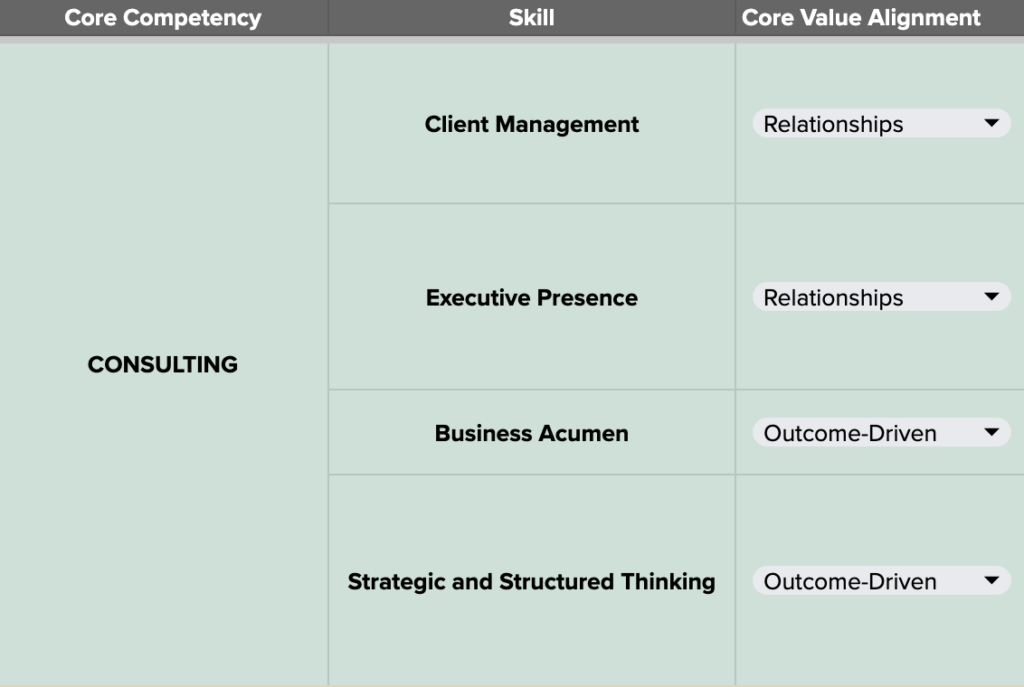Table of Contents
Why Implementing a Skills Matrix is an Essential Element to Agency Life
As we're growing our team, we're taking a deeper dive into career growth here at Uproer.
Everyone knows that SEOs don't get better by magic, but there is some mysticism around how to really build SEO skills. You can go the hard skills route and really just give your analysts and senior analysts task after task, and eventually they'll figure out how to build their skills into something that speaks to the client. Or you can go the soft skills route, and lean into the story-telling element of our jobs.
But like everything, it takes both to succeed - the art and the science. We've spent a few years working through how best to visualize and connect with our team's development - both hard and soft skills - and articulating how that all leads into capacity planning so we can execute cool s*** like Offline Fridays.
Read on to see how we built our cool new skills matrix over the course of 6 months.
Measuring Career Growth In Any Field Is A Challenge
The big goal behind all of this career growth measurement is to de-mystify how someone is doing in their work. That's all. Goodbye, fears of failure or imposter syndrome! Cya later, surprise promotions (or firings)! Adios, general anxiety about work! If we keep clarity at the forefront, measuring success should be easy, right?
Generally, the information that's out there today is really geared towards more traditional roles and organizations - think corporate business, government, and universities dominating. There really isn't a "Google-able" template, answer, or starting point for agencies or more creative roles - arguably, the roles that need it most!
Why is measuring career growth important?
Growth and demonstrating growth in the role are important for 4 reasons.
Job satisfaction and happiness
It's the workout philosophy, when the team sees their progress, they're more likely to feel happy in their work and engage more with internal initiatives. Job satisfaction is a little intangible, and often only comes up when someone is having a negative experience, or not experiencing satisfaction. This means it has to be a priority and run as an intentional undercurrent in your culture all of the time.
Capacity planning - hiring, firing, restructuring, promotions
Career growth planning helps us put tangible barriers to how someone is performing. Career growth measurement sets the scene for the leadership team and the team itself. There are clear expectations for all parties and we can better assess strengths and weaknesses across longer periods. Using a skills matrix helps us:
- Plan capacity by identifying the percentage of the team that is performing vs underperforming, which can help us calculate work distribution, and therefore if it's time to hire someone.
- Redistribute work more equitably and gives us more levers to pull to level out work across the entire team.
- Let team members shine and aspire to more.
- Pull together performance plans if and when appropriate.
Honing skills and building new ones
Clear, measurable outcomes and milestones help the team to understand exactly what is in their job description currently and in the future. It helps them grow in ways that'll benefit their career and deprioritize work that may be only tangentially related to their role. Essentially, measuring career growth helps keep employees sharp and output consistent.
Some pain points of our previous approach
As a growing company, we had some growing pains with tracking our team's success. They mostly stemmed from... well, not having a tracking system.
It wasn't until we ran up against some budding stars of SEO on our team that were ripe for a promotion. We were put on the spot to explain the next step of their careers, so we came together to build our initial milestone and progression chart matrix.
We built two spreadsheets - a milestones checklist and a skill rubric which we measured on a graded scale.
Now, this was a very simple matrix and an even simpler checklist that measured team success across 3 key competencies: Knowledge + Skills, Personal Success, and Client Success. Each of those areas was broken down into key expertise for that competency, including things like goal setting, executive presence, team communications, and work quality and execution.
While this is great at laying out how to think about these different areas of success, we knew there was more to go. Here are the biggest pain points we had with the existing rubric.
Here are the biggest pain points we had with the existing rubric:
- Binary Milestones
- Inadequate Grading System
- Lack of Compensation and Title Mapping
The milestones are binary: either you’re able to do something or you’re not
While this gives some consistency in measurement and a clear YES/NO answer, it doesn't leave room for measuring skill maturity. You may be able to do something, but can you do it as well as you’ll be able to in 3 years? No, and we needed a way to account for this.
The rubric has the same problem. It may add more nuance in that, it asks the user to assign a letter grade rather than checking each item off as complete, but it doesn’t account for skill maturity.
Letter grading just isn’t the right fit
We initially went with letter grading in our rubric because it was the easiest way to bring people along for the ride.
But letter grading creates a weird authority dynamic. Nobody wants to feel graded like they’re back in elementary school. We’re social people who care about each other and there’s mental friction that prevented us, even just slightly from giving our peers poor letter grades.
Letter grading also isn’t constructive. Why a B and not an A? What’s missing that would improve the grade? It was still based on gut feeling - sure we had something to react to and weren't flying blind, but we sure weren't being objective.
Our current milestones aren’t mapped to compensation or title
The heading says it all. We never connected milestones and your "grade" to compensation or title advancement. In the name of clarity and transparency, we put our salary bands on all of our job descriptions, meaning we have them available to add to internal documents.
How We Changed Our Matrix to Better Align With Our Experience, Values, and Progression Tracks
Dave Sewich and I took on the task of tearing down our existing skills matrix and building this one up. We're so excited to roll it out to our team, and we see this being a great internal resource for years to come.
It took almost a quarter to really get into the nitty-gritty of it all - running interviews, getting perspectives, building a plan, and executing the building of that plan in a tangible matrix. But in the end, we have something that really exemplifies what it's like to work at Uproer at every level. At least as an SEO. Don't worry, paid, you're up next!
Aligns with our values
In the last quarter of 2022, we re-designed and had a deeper think about the company's values. What does it mean to work here and what do we want our employees to feel? You can see our core values here. It was important to us that these values were represented in how we track everyday and long-term experience and growth at Uproer. Each segment in the new matrix corresponds to at least one of our new values:

| Skill | Core Value Alignment |
| Client Management | Relationships Yield Results |
| Executive Presence | Relationships Yield Results |
| Business Acumen | We are Outcome-Driven |
| Strategic and Structured Thinking | We are Outcome-Driven |
This not only helps keep them front of mind, but we can ask ourselves "Am I being outcome driven", or "am I valuing relationships", or "am I doing the right thing?" and can point to exactly how I can improve that notion in my work and work life.
Uses "I" language
"I" language helps the team feel like they can envision themselves in the position above and really identify themselves in their current position. This promotes a sense of ownership and motivation to succeed and achieve their role description.
This was an important one for us - we wanted the team to feel connected to their roles and broader goals of the company, and by simply using "I" language, we're able to draw out feelings of connection and improve general morale in the team.
They put emphasis on soft skills or character traits
One of our new core values is that relationships yield results. This emphasis on soft skills and developing lifelong character and behaviour traits is how we believe we get such great results for our clients. Better defined as “behaviours”, soft skills like dependability, motivation, and enthusiasm are essential to how we work and are crucial for moving up at work.
Further Progression
While the previous milestones and rubric were binary, the new matrix is onward leading. Where we only had analyst and senior analyst milestones and rubrics, we now have laid out our senior manager job title.
Leaves room for the "magic middle"
The magic middle is a term that we use internally to talk about the "magic" and art that happens in the middle of executing a process.
Whether you're working on a project or you're working on your career goals, there's a clearly defined beginning (or input) and there's a clearly defined end (or output), but then there's the middle. You have three options for the middle of the process. You can either:
- Leave it wide open to interpretation by the one executing the task or project,
- Provide guidance and notes on how things should look or feel when working through the process, or
- Give step-by-step instructions on how to execute the task.
All three of these are valid methodologies to get from point A to point B, but for the development of staff and training that staff, we have chosen to go with path 2. We feel like we can give enough guidance across our core competencies and skills that we give people the opportunity to flourish and blossom into their own roles.
Our Next Steps
Regardless of where we are today, we embrace a culture of continuous learning and development. That means there's always something more to do to promote a healthy, happy, transparent development culture.
Our next steps are to add some more specific examples per each core competency to provide a little more clarity to our newer hires. We'd also like to expand the scope to add interns, and directors, and build out the SEM matrix to accompany our paid search folks' careers.
Right now, we're implementing our new matrix with the help of the team.
If you're curious about working at Uproer and what it's like to be here, you can check out our careers page for up-to-date openings and our interview process.

